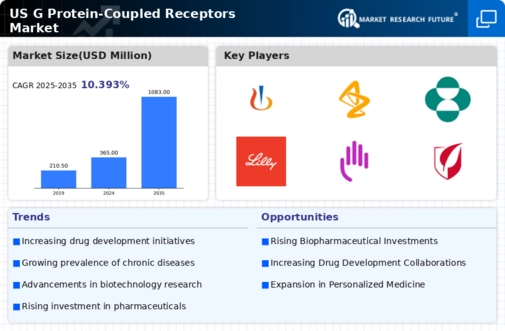Rising Focus on Rare Diseases
The increasing focus on rare diseases is emerging as a pivotal driver for the g protein-coupled-receptors market. As regulatory bodies and pharmaceutical companies prioritize the development of treatments for rare conditions, GPCRs are gaining attention due to their involvement in various rare diseases. In 2025, the market for rare disease therapies in the US is projected to surpass $200 billion, with GPCR-targeted drugs likely to play a significant role. This trend indicates that pharmaceutical companies may allocate more resources towards researching GPCRs associated with rare diseases, potentially leading to breakthroughs in treatment options. As a result, the g protein-coupled-receptors market could experience substantial growth, driven by the demand for effective therapies for these underserved patient populations.
Expansion of Research Collaborations
Collaborative research efforts among academic institutions, pharmaceutical companies, and biotechnology firms are becoming increasingly prevalent in the g protein-coupled-receptors market. These partnerships facilitate the sharing of knowledge, resources, and technology, which can expedite the discovery and development of new GPCR-targeted therapies. In 2025, it is estimated that collaborative research funding in the US will reach $50 billion, with a substantial portion dedicated to GPCR research. Such collaborations not only enhance the scientific understanding of GPCRs but also streamline the drug development process, potentially leading to faster market entry for innovative therapies. This collaborative environment is likely to foster a culture of innovation, driving the g protein-coupled-receptors market forward.
Advancements in Drug Delivery Systems
Innovations in drug delivery systems are poised to impact the g protein-coupled-receptors market positively. Enhanced delivery mechanisms, such as nanoparticles and targeted delivery methods, are being developed to improve the efficacy and safety of GPCR-targeted therapies. In 2025, the drug delivery market in the US is expected to reach $200 billion, with a notable emphasis on systems that optimize the delivery of GPCR modulators. These advancements may lead to improved patient compliance and therapeutic outcomes, as drugs can be delivered more precisely to the intended site of action. Consequently, the g protein-coupled-receptors market is likely to benefit from these technological improvements, as they facilitate the development of more effective and safer GPCR-targeted treatments.
Increasing Investment in Biotechnology
The g protein-coupled-receptors market is experiencing a surge in investment from both public and private sectors. This influx of capital is primarily directed towards research and development initiatives aimed at discovering novel therapeutic agents targeting GPCRs. In 2025, the biotechnology sector in the US is projected to reach approximately $300 billion, with a significant portion allocated to GPCR-related research. This financial backing is likely to accelerate the pace of innovation, leading to the development of new drugs that can effectively modulate GPCR activity. Furthermore, as investors recognize the potential of GPCRs in treating various diseases, including cancer and neurological disorders, the market is expected to expand, fostering a competitive landscape that encourages further advancements in GPCR-targeted therapies.
Growing Demand for Personalized Medicine
The shift towards personalized medicine is significantly influencing the g protein-coupled-receptors market. As healthcare providers increasingly adopt tailored treatment approaches, the need for drugs that target specific GPCRs becomes more pronounced. In 2025, the personalized medicine market in the US is anticipated to exceed $100 billion, with GPCRs playing a crucial role in the development of targeted therapies. This trend suggests that pharmaceutical companies are likely to invest more in understanding the genetic and molecular profiles of patients, thereby enhancing the efficacy of GPCR-targeted treatments. Consequently, the g protein-coupled-receptors market may witness a transformation, as therapies become more aligned with individual patient needs, potentially improving treatment outcomes and patient satisfaction.

















Leave a Comment